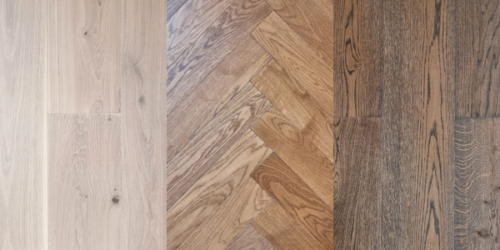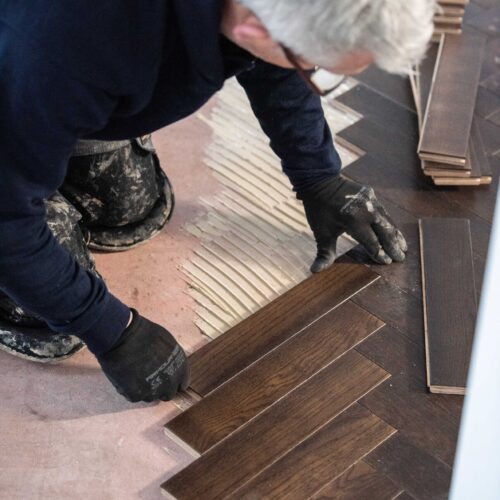Frequently Asked Questions
Here you will find answers to some of our most Frequently Asked Questions.
We’ve grouped them into topics such as Choosing Your Wood Flooring and Installation, to help you find what you’re looking for more easily.

It can be tricky to know where to start when it comes to choosing your wood flooring. We’ve answered some FAQs below to help you make more informed decisions and to guide you to your perfect floor.
Our engineered wood flooring combines a durable, high-quality European oak top layer with a high-grade water-resistant birch plywood base. These boards offer all the natural beauty and durability of solid oak flooring along with the outstanding structural stability, enduring performance and sustainability benefits of modern plywood base.
Find out more about how our engineered wood flooring is manufactured here: How is Wood Flooring Manufactured?
High-quality engineered floorboards have many benefits over solid wood flooring. These versatile boards are specifically designed to be structurally stable, resisting the wood’s natural expansions and contractions — therefore, they can be installed over underfloor heating systems. They are also more sustainable to produce, easier to fit, and just as durable as a solid oak floor.
Engineered boards are also more widely available in greater widths, with an array of options for different wood species too.
Find out more here: Why Choose Engineered Wood Flooring?
Due to its structural stability, high-quality engineered wood flooring is the best wood flooring choice for kitchens and bathrooms, and any rooms where there are likely to be higher levels of humidity.
Yes. At Chaunceys, we believe that wood flooring is a superior choice in any room, including kitchens and even bathrooms. We have supplied and installed our wood flooring in bathrooms —with great success — for many projects across the UK. That said, taking a little care and choosing the right kind of engineered wood flooring is vital if you want your floor to stay beautiful.
Find out more here: Is Wood Flooring in a Bathroom a Good Idea?
If you’re installing your wood flooring directly onto your joists, you’ll need to go for planks with a load bearing thickness that is a minimum of 18mm. Opt for our 20mm thick Bristol Tectonic® planks if this is the case.
Our 15mm thick planks need to be laid onto a solid subfloor such as concrete or you can use 18mm plywood to create a load-bearing subfloor for our 15mm planks. Of course, options for adding this extra material will depend on your floor height limitations.
Find out more here: How Thick Should Engineered Wood Flooring Be?
Oak is a very resilient wood and offers durability alongside great value for money. It’s a wood that has been used as flooring for centuries and has never gone out of fashion. Ash flooring is strong-grained and very hard-wearing — in fact, naturally tougher than oak.
Oak flooring is still the most popular choice due to its balance of toughness, sustainability, and natural beauty.
Find out more here: Which Wood Flooring is the Most Durable?
Prefinished engineered floorboards are the quickest and easiest way to create luxurious wood flooring. Once the fitter fixes our prefinished planks to the subfloor, there should be no further work required to create your perfect floor.
Find out more here: 5 Benefits of Prefinished Wood Flooring
Simply browse through our huge range of finishes and inspiring projects and add your favourites to your basket. With so many options to choose from — including different colours, wood species, textures and grades — nothing compares to seeing and handling a physical sample to help you imagine your perfect floor in your home.
You can quickly order up to 4 samples online, but if you need more feel free to get in touch with our Customer Services team who will be happy to organise this for you.
We’ve answered the below FAQs on the ordering and delivery process to clear up a few questions that might crop up as you get closer to placing your order.
When working out how much flooring you need, we generally advise adding wastage of around 10% for planks and 12-15% for parquet, such as Herringbone or Chevron. For reclaimed timber products, we advise a higher percentage of wastage of around 15-20%.
Responsible wood flooring suppliers will ensure that this additional percentage of material is added to your room’s square meterage. The inclusion of wastage is standard practice across the wood flooring industry; no one wants the delays and drama of running out of planks at the last minute.
Find out more here: How Much Wastage Do You Need to Allow for Wood Flooring?
We use our own flatbed truck for local deliveries (usually up to 130-mile radius from Bristol). For larger deliveries, and ones that are further away from us, we use trusted freight companies that offer a kerbside delivery. We will contact you the day before your delivery is due to confirm details.
Please allow for help to be available on-site with the offload. If this is not possible, please let us know and we will make arrangements to ensure a safe, successful delivery.
Due to the nature of timber, your wood flooring should always be fitted at the final stage of any building project — and only when the site is ready.
The building must be weather tight, with all outside doors and windows in place, and with an electricity supply available. All ‘wet’ work must be complete and thoroughly dry, and the subfloor must be secure, clean, flat, level, and dry i.e., checked for moisture content. Ensure the environment is consistent in temperature and humidity levels and that the space is clear of furniture and ready for works to start, ideally with no other trades working at the same time in the same area.
Find out more here: Suitable Site Conditions For Wood Flooring
When it comes to creating beautiful, long-lasting wood flooring, the aim is to keep the planks’ moisture content as stable as possible. So, acclimatising your wood flooring prior to fitting is a vital step, allowing the wood’s moisture content to stabilise on site (the site’s Relative Humidity levels should be consistent and within 40-65% RH).
We recommend the following pre-fitting acclimatisation periods (as a minimum): 72 hours for engineered boards, 10 to 14 days for solid wood boards, 3 weeks for reclaimed boards.
Find out more here: What Is the Ideal Moisture Content for Wood Flooring?
Some FAQs on wood flooring installation.
Yes, you can — providing that your concrete or screed is clean, flat, dry, level, and free of laitance.
In most circumstances, we highly recommend fully bonding (gluing down) wood flooring to the concrete for a solid, high-end feel with no bounce.
Find out more in our guide via the link: How to Install Wood Flooring Over Concrete
Absolutely. High-quality engineered wood flooring is ideal for installation over underfloor heating systems due to its structural stability.
Find out more in our guide via the link: Can You Put Underflooring Heating Under Wood Flooring?
Yes, you can ‘float’ the boards over an underlay. Floating is a popular cost-effective choice for DIY wood flooring installation and there are certain situations where it can be a good option, such as when there is a need for noise reduction. That said, we highly recommend fully bonding the floor to a solid subfloor instead because it gives a more solid, durable feel than a floated floor, with less bounce underfoot.
Find out more in our guide via the link: Does Engineered Wood Flooring Need Underlay?
If you have successfully installed wood flooring before and are confident in your abilities, it is possible for you to install the flooring yourself. However, we always highly recommend that wood flooring is installed by an experienced professional floor fitter.
To ensure your project comes together beautifully from start to finish, Chaunceys offer a complete supply and fit service for wood flooring, using our skilled craftspeople with decades of combined experience.
Find out more about our expert Fitting Service here.
We believe fully bonding wood flooring to a solid subfloor is the best installation method. Whilst you can use other methods — such as secret screws/nails, or floating the boards on an underlay — using a flexible flooring adhesive to bond the flooring to a solid subfloor is our recommendation for achieving the best results.
Whilst we don’t build staircase structures, we can clad stairs with our wood flooring planks to achieve your desired look. Our team has a wealth of experience in transforming existing staircases to integrate them harmoniously with our wood flooring, and in using our high-quality planks to create striking, bespoke wooden feature staircases.
Find out more here: Wood Flooring on Stairs
Generally, we recommend laying planks perpendicular to floor joists, in the same direction as the longest wall of your room, i.e., parallel to the longest dimension.
For those who like to do things a little differently, another option is to install the flooring planks diagonally. This can be very effective in larger spaces.
When you’ve installed your dream wood flooring, you’ll want to make sure it always looks its best and lasts for a lifetime. Wood flooring needs a little care and attention to keep it looking beautiful, so we’ve compiled these FAQs to quickly give you the answers to any care and maintenance questions you might have.
Keeping your wood flooring clean is key to maintaining it. Hardwood flooring does require some attention to keep it looking at its best, but it shouldn’t be a daunting task. Using the right kind of cleaner is important, though. Household cleaners, and detergents can be too abrasive and are likely to damage the finish and cause a lot of problems. Any harsh chemicals should be avoided.
Our Eco Wash Care is an environmentally friendly, PH neutral floor cleaning system designed for cleaning oiled and lacquered wood flooring.
Find out more here: What Should You Use to Clean Wood Flooring?
Please don’t. We strongly advise against using any steam-cleaning equipment on wood flooring. This kind of aggressive cleaning is unnecessary and will damage your flooring.
Some preventative care along with a routine of cleaning and occasional maintenance should keep your oiled wood flooring fully protected and ensure it remains naturally beautiful.
Find out more here: How To Maintain Your Oiled Wood Flooring
Some simple preventative care along with a routine of cleaning and maintenance should keep your lacquered wood flooring fully protected and ensure it stands the test of time.
Find out more here: How to Maintain Your Lacquered Wood Floor
In busy homes there are bound to be accidents, and wood flooring can get damaged despite all your efforts to avoid dents and scratches, We offer maintenance products and touch up repair kits that can help. Contact us with photographs of the damage and we will help as best we can.
Our engineered wood flooring has a high-quality hardwood top layer, so carefully sanding back your planks a few times shouldn’t cause any problems. That said, there’s a limit to how many times you can sand your wood flooring, so it’s best to avoid doing so if possible.
We would advise trying all other options to revitalise your wood flooring before deciding to sand. However, a full sand and refinish might be the only way to go if there are stubborn marks from water damage, or if there are deep scratches and dents.
Find out about our Floor Refinishing Service here.
Still Unsure of Something?
Contact our friendly team who are happy to help with whatever you need.
Other Resources
A range of other useful resources to explore, including buyers’ guides on helping you to choose the right flooring, care and maintenance advice, as well as technical articles on installation.

News & Insights
Find out our latest news — from awards, new team members, and company events through to our latest tree planting adventures.

Buyers’ Guides
A range of helpful guides to help you choose your perfect floor – the difference between lacquered and oiled floors, our wood grading explained and much more.

Technical Guides
A selection of technical advice articles – from advice on fitting floors, the best kind of underlay to use, and how to take moisture readings.
